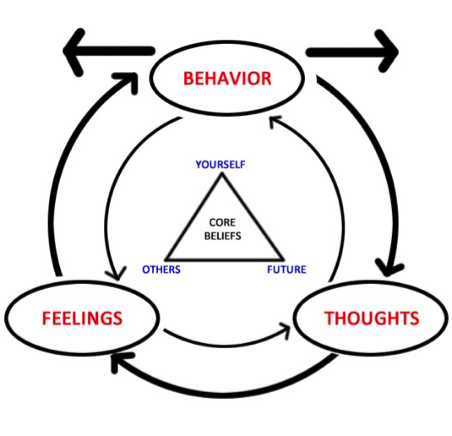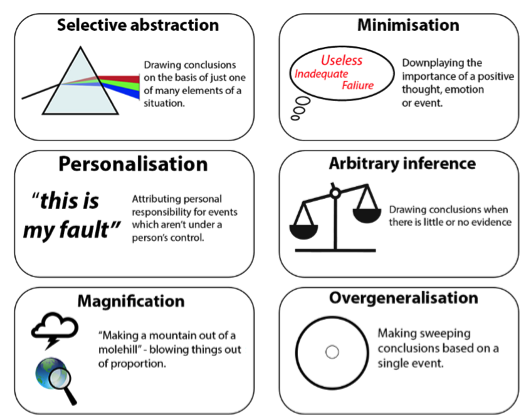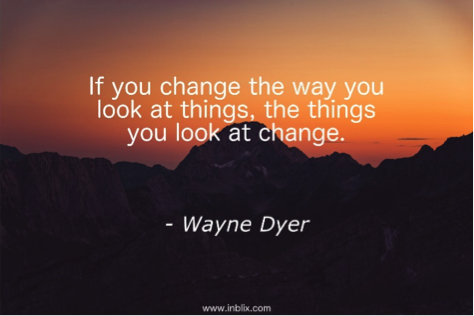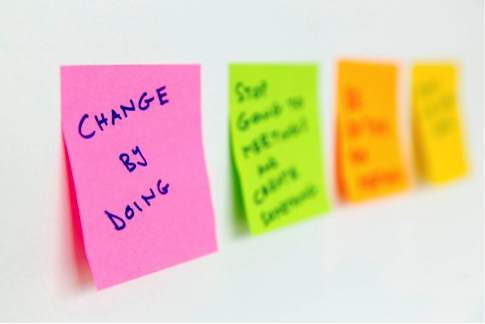By: Lauren Hallerud, MA, LPC
If you are new to the world of mental health or are beginning to seek services for a therapist, individual or group therapy, Partial Hospitalization program (PHP), or Intensive Outpatient program (IOP), chances are that you have heard or come across the acronym “CBT” before. So, what is CBT, why is this such a buzz word in the world of therapy, and how does it work?
Let us begin by defining CBT:
Cognitive Behavioral Therapy (CBT) is a therapeutic approach and form of talking therapy that can help manage your problems by changing the way you think and behave. It is also a short-term, goal-oriented psychotherapy treatment that takes a hands-on and practical approach to solving problems. CBT states that our thoughts, feelings, behaviors, and physical symptoms are all connected and that they all impact one another. While we cannot always change the way we feel about something, we can change the way we react or respond to something in our behavior (verbally, physically, behaviorally) and we can change the way we talk to ourselves and work with the thoughts that automatically pop into our minds.
The goal is to change patterns of thinking and behavior that are unhelpful, unhealthy, and problematic and to in turn change the way you feel, even if just to soften or slightly increase a feeling. CBT focuses on first becoming aware of and identifying, then challenging and changing unhelpful cognitive distortions (thoughts or beliefs that are warped from reality) and behaviors, improving emotional regulation, and the development of personal coping skills that target solving current problems. The “Cognitive Triad” or “Cognitive Triangle” that appears below is a common visual model showing the relationship between our thoughts, feelings, and behaviors used in CBT.

How it works:
A primary goal of CBT is to teach individuals that while they cannot control all aspects of their environment, others, or the future, they can take full control of how they interpret or understand experiences and manage their response to their immediate environment. Ultimately, reality is that we all get to choose how we respond to different situations and stressors we face in life. Again, while we cannot always change the way we feel about something, we can very much change the way we talk to ourselves or respond physically, verbally, or behaviorally. Once we embrace the idea that we can only control ourselves and what we say or do, the pressure or anxiety around trying to control everything in our environment can begin to fade and we tend to feel more at peace and in control of ourselves.
What does CBT involve?
While therapists may use CBT techniques differently and use different techniques specific to the individual client they are working with, often times CBT asks clients to complete homework assignments typically recording their thoughts and feelings, helps individuals become aware of and understand their individual patterns, learn coping skills and new more effective behavioral responses and thought processes, teaches breathing techniques, mindfulness, relaxation, and grounding techniques (being more in the moment).

What diagnoses or conditions is CBT effective in treating?
CBT is most commonly used to treat depression, anxiety, Obsessive Compulsive Disorder (OCD), attention difficulties, substance use and addictions, Post-Traumatic Stress Disorder (PTSD), sleep concerns, as well as eating disorders, but can be useful for other mental and physical health problems. It has been found to be effective in treating many physical symptoms that often go hand in hand with psychological disorders, such as Irritable Bowl Syndrome (IBS), digestive issues, chronic fatigue syndrome, and chronic pain.
CBT is also a therapeutic approach effective for all ages extending its benefits across the lifespan, cultures, and populations.
CBT for Children:
Another great aspect of CBT is that it can be taught in children’s terms and its terminology can be expressed on their level. By using visual and hands on lessons, children can learn how their thoughts impact their emotions and behaviors. They can also learn to feel more in control of themselves by challenging negative or unhelpful thoughts, learning to think more positively and realistically from an earlier age. They can also learn to put words to feelings and become more expressive after becoming more self-aware and understanding of what is happening to them both mentally and physically in certain moments.
CBT for Adolescents:
In addition to the benefits that CBT can provide for children, it can have the same for older individuals. For adolescents, CBT is something adolescents can buy into as it is directly related to the individual, their habits, their routine, etc. It can teach adolescents to take ownership and responsibility for their words, behaviors, and overall reactions to things, as well as open their eyes to a more logical and realistic way of thinking.
CBT for Adults:
Even adults, sometimes perceived to be stubborn or “set in their beliefs or ways” can very much modify the way they think or respond to stressors. With age and life experience often brings increased insight and self-awareness that can make the approach of CBT that much more effective.

Benefits of CBT:
So why seek CBT over other types of therapy? There are multiple benefits of utilizing CBT in individual or group therapy, as it is;
-Individualized and specific to the patterns and concerns of the client.
-Cross-cultural: it is based on human behavior and is focused on the clients’ goals, not purely the goals of the therapist.
-It has been heavily researched and has numerous clinical studies providing evidence-based results.
-It can be completed in a shorter period of time than other forms of therapy. Due to being focused on the present problems and being solution-focused, CBT can be used and applied more quickly to current stressors and in a variety of settings.
-It is very instructive and straight forward making it easier to understand, believe in, and to apply to one’s life or current problems.
-It is skills based which can help mood and anxiety disorders get better, rather than only focusing on feeling better. It addresses the underlying or root issues that lead to low mood, anxiety, etc. and changes the thought process and response behind the problematic thoughts or behaviors.
-It can be as effective as medication in treating depression without needing to put anything into the body, but knowledge. Treating depression or anxiety with a combination of medication and CBT has been found to be highly effective.
Overall, Cognitive Behavioral Therapy is one of the most commonly used, respected, and preferred forms of treatment in the world of psychotherapy. Both clients and clinicians appreciate its effective and practical approach towards working through and resolving common everyday problems, as well as more deep-rooted ones. If you have any questions regarding CBT or are interested in trying CBT, please feel free to contact our team via the contact form on our website or call us at (847) 821-1450.


